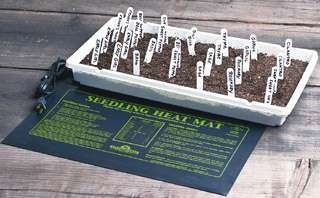 Hello
Hello
Are there electric heater covers available for carboys or plastic fermenters to keep the working wine at a constant temperature? I have no ideal place in my location where a constant temp is available.
Thank You
Carl M.
———-
Hello Carl,
The difficult part about keeping a fermentation artificially warm is that you need a very mild heat source. It is easy to over-heat a fermentation and ruining the wine must with too much heat.
An example of this would be an electric blanket. Every electric blanket I’ve seen would make a fermentation way, way too hot — even on their lowest settings. In fact, we’ve had customers attempt this with great failure.
Besides keeping the room’s ambient temperature between 70F and 75F, there are two simple methods I’ve seen work fairly well for keeping a wine fermentation warm.
The first method is to use a 100 watt incandescent light bulb. If you can still find one. Put it in an old lamp and put it off to the side of the fermenter about 12 inches. This will raise the temperature of 5 gallons about 8 to 10 degrees. Because light can promote oxidation in a wine, this works best with a opaque plastic fermenter, but I’ve used this method with clear, wine carboys, too. I just wrapped a heavy towel around it to guard it from the light.
The second method I’ve seen work is using a seedling heating mat. This is a little mat you can buy at a gardening supply retailer. They are used to keep nursery plants warm while sprouting in the early months. They are a very mild source of heat and are about the right size for a wine carboy or a typical plastic fermenter.
One of your best friends in these types of situations is a thermometer. Keeping a very close eye on the temperature when the temperature is so volatile is crucial to a successful fermentation. That is why I would urge you to buy a Liquid Crystal Thermometer for each wine carboy of plastic fermenter you have.
I hope this information has helped you out a bit and given you an idea of what needs to happen. I’m sure there are other ways to keep a fermentation cozy, some that haven’t even be thought of yet, but at least now you have some clue as to what is needed.
Best Wishes,
Customer Service
———————————————————————————————————
Ed Kraus is a 3rd generation home brewer/winemaker and has been an owner of E. C. Kraus since 1999. He has been helping individuals make better wine and beer for over 25 years.

I like to use a space heater that has a control setting that ranges form 60 degrees to 85 degrees so that I can have the room temperature at a steady 70 degrees without fluctuation.
HAVING TROUBLE GETTING FERMENTATION STARTED. PLUM WINE THAT HAS BEEN COOKED , IS THERE ANY THAT I CAN REVITALIZE?
John, the first place to start is to take a hydrometer reading to confirm that there has not been a fermentation. It is possible for a fermentation to be done in as little as 2 or 3 days. Also, I would strongly urge you to go through the "Top 10 Reasons For Fermentation Failure". You can find this under the articles section of our main website. This article will help you to know where your batch of wine stands and what you should do.
Like your idea on the seedling heat mat. would you put the carboy rite on the mat.(seems to heavy) or wrap the mat around the carboy?
John, you can strap it to the side if you’d like, but it is not necessary. Sitting the fermenter on the mat works fine. The warmer wine will rise to the top and force the cooler wine to the bottom until it is all an even temperature. I would also like to point out that since the post was written we have added the Copper Tun Heating Pad that essentially does the same thing.
Copper Tun Heating Pad
http://www.eckraus.com/heating-pad-fermentation.html
How long do you need to keep the must @ or around 75 degrees?
John, you need to keep the must at 70°F. to 75°F. until all the yeast activity has completed. It is the yeast that need this temperature not the must to be more specific. Once you have verified with a hydrometer that all the sugars have been fermented, you are free to let the wine become cooler. However, letting the temperature rise is never a good thing. It promotes oxidation and spoilage.
Can I use a wine brewing heater to make beer